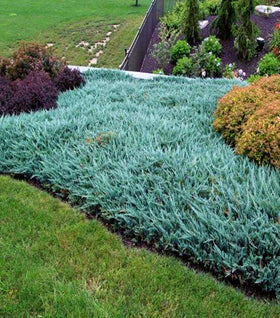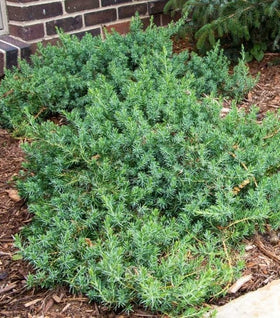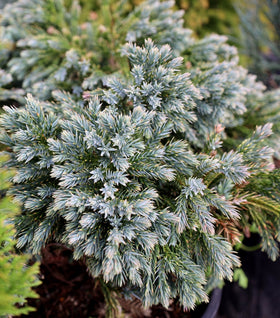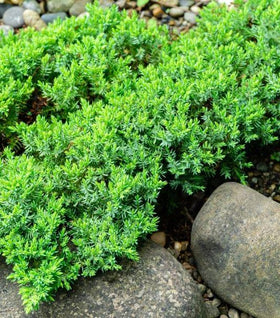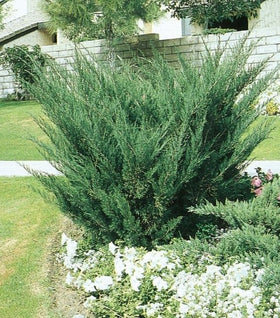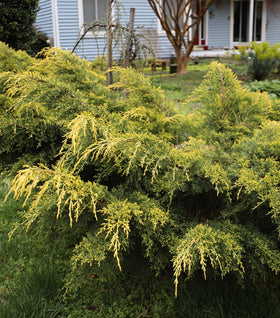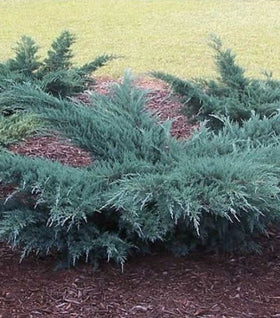Juniper Shrubs for Sale Online
Juniper shrubs are versatile, evergreen plants that come in a wide range of sizes and shapes, making them ideal for any landscape. Junipers can be categorized into low-spreading groundcover varieties, mid-sized spreading shrubs, and tall, columnar types perfect for creating vertical accents. These hardy shrubs are one of the most low-maintenance options available, thriving in full sun and well-drained soils. Juniper shrubs also perform well in poor or rocky soils, making them a great choice for tough growing conditions where little else will thrive.
Juniper shrubs are drought-tolerant and perfect for rock gardens, slopes, or ground cover to prevent soil erosion and suppress weeds. Their resilience makes them an excellent choice for containers or patio pots, where they require minimal care. Most varieties of juniper need little to no pruning, adding to their appeal as easy-care landscaping plants. Whether you're looking to fill a difficult-to-access area of your yard or create a stunning focal point, juniper shrubs offer beauty, durability, and functionality to any outdoor space.
How and Where to Plant Juniper Shrubs In the Landscape
When planting juniper shrubs in the landscape, it's important to choose the right location to ensure they thrive. Junipers prefer full sun, needing at least 6 hours of direct sunlight each day. They are highly adaptable to various soil types, but the key to success is ensuring well-drained soil. If your soil tends to retain moisture, consider amending it with sand or gravel to improve drainage. Junipers do not tolerate soggy conditions, so avoid planting them in low-lying areas that collect water.
Juniper shrubs can be planted in a variety of landscape settings depending on their size and shape. Groundcover junipers are excellent choices for sloped areas or hillsides, where they help prevent erosion and provide a low-maintenance, weed-suppressing carpet of foliage. For garden borders or along walkways, mid-sized spreading juniper shrubs create a lush, dense barrier. If you're looking to add height or structure to your landscape, upright or columnar junipers can be planted in rows to form a privacy screen or as individual specimens to serve as focal points in your garden.
Junipers are also well-suited for rock gardens, xeriscapes, or other low-water-use landscaping areas. Their drought tolerance and ability to grow in poor, rocky soil make them a perfect fit for dry, difficult-to-cultivate spots where other plants struggle to survive. Because they require little water once established, they are an ideal choice for water-wise gardens, blending seamlessly into natural settings with minimal maintenance.
When planting junipers, it’s important to provide adequate space for their mature size, allowing them to spread and grow without overcrowding. Dig a hole twice the width of the root ball and as deep as the container the plant came in. Place the juniper in the hole, backfill with soil, and water thoroughly to help settle the roots. Mulching around the base of the plant can help retain moisture and reduce weeds, but be careful not to cover the crown of the plant to prevent rot. Whether used as ground cover, a privacy hedge, or a statement plant, junipers are versatile, easy-to-grow additions to any landscape.
How to Care for Juniper Shrubs in the Garden
Due to their hardy and low-maintenance nature, caring for juniper shrubs in the garden is relatively easy. Once established, junipers require minimal attention, making them a great choice for busy gardeners or those looking to create a low-effort landscape. Junipers are drought-tolerant and thrive in well-drained soils, so regular watering is only necessary during the initial establishment phase, typically the first year. After that, they can rely on natural rainfall, except in prolonged dry periods when occasional deep watering will be beneficial.
Pruning juniper shrubs is not always necessary, as most varieties maintain a naturally attractive shape. However, light pruning can be done to control growth, maintain size, or shape them to your desired look. It's best to prune junipers in late winter or early spring before new growth begins. Be careful not to cut into old wood, as junipers do not regenerate well from older, woody stems. Instead, focus on trimming the green, new growth to encourage a fuller, more compact appearance.
Fertilizing juniper shrubs is also a simple task. These plants typically do not require much feeding, especially if planted in healthy soil. However, if you notice slower growth or pale foliage, a balanced slow-release fertilizer applied in early spring can help boost their vigor. Avoid over-fertilizing, as too much nitrogen can cause leggy growth and make the shrubs more susceptible to pests and diseases.
Another aspect of caring for junipers is keeping an eye out for common pests and diseases, though these shrubs are generally resistant to most issues. Spider mites and scale can occasionally pose a problem, especially in hot, dry conditions. Regularly inspecting your plants and using a strong spray of water or insecticidal soap if needed can help control infestations. Junipers can also be prone to fungal diseases if planted in overly moist or poorly drained areas, so proper site selection and good air circulation are key to maintaining healthy shrubs.


